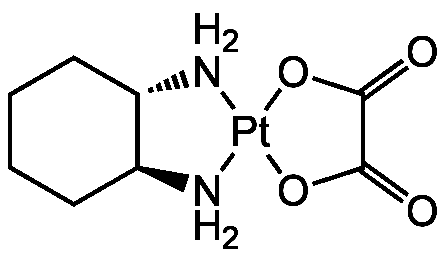Oxaliplatin
| Code | Size | Price |
|---|
| AG-CR1-3592-M005 | 5 mg | £30.00 |
Quantity:
| AG-CR1-3592-M025 | 25 mg | £55.00 |
Quantity:
| AG-CR1-3592-M100 | 100 mg | £120.00 |
Quantity:
Prices exclude any Taxes / VAT
Overview
Regulatory Status: RUO
Shipping:
-20°C
Storage:
+4°C
Images
Documents
Further Information
Alternate Names/Synonyms:
1-OHP; ACT 078; RP 54780; NSC 266046; Diaminocyclohexane oxalatoplatinum
Appearance:
White to off-white powder.
CAS:
61825-94-3
EClass:
32160000
Form (Short):
liquid
GHS Symbol:
GHS07
Handling Advice:
Keep cool and dry.Protect from light and moisture.
Hazards:
H315, H317, H319, H335
InChi:
InChI=1S/C6H14N2.C2H2O4.Pt/c7-5-3-1-2-4-6(5)8;3-1(4)2(5)6;/h5-6H,1-4,7-8H2;(H,3,4)(H,5,6);/q;;+2/p-2/t5-,6-;;/m0./s1
InChiKey:
ZROHGHOFXNOHSO-USPAICOZSA-L
Long Description:
Chemical. CAS: 61825-94-3. Formula: C8H14N2O4Pt. MW: 397.3. Potent platinum-based antineoplastic agent with wide spectrum anticancer activity. Anticancer compound. Forms inter- and intrastrand DNA adducts/crosslinks, consequently blocking DNA replication and transcription and inducing cell death. Shows antitumor activity in cisplatin resistant cell lines. Shows better biochemical, pharmacological and cytotoxic properties than cisplatin (Prod. No. AG-CR1-3590) and carboplatin (Prod. No. AG-CR1-3591). Apoptosis inducer. Targets other proteins and enzymes. Anticancer activity and antitumor specificity depends on selective uptake through human organic cation transporters 1 (OCT1) and OCT2. Neurotoxic profile depends on organic cation transporter 2 (OCT2) uptake.
MDL:
MFCD00866327
Molecular Formula:
C8H14N2O4Pt
Molecular Weight:
397.3
Package Type:
Vial
Precautions:
P261, P271, P280, P312
Product Description:
Potent platinum-based antineoplastic agent with wide spectrum anticancer activity [2, 7-9]. Anticancer compound. Forms inter- and intrastrand DNA adducts/crosslinks, consequently blocking DNA replication and transcription and inducing cell death [1, 4, 7, 10, 13]. Shows antitumor activity in cisplatin resistant cell lines [3, 8]. Shows better biochemical, pharmacological and cytotoxic properties than cisplatin (Prod. No. AG-CR1-3590) and carboplatin (Prod. No. AG-CR1-3591) [5, 7, 8]. Apoptosis inducer [10, 11]. Targets other proteins and enzymes [6]. Anticancer activity and antitumor specificity depends on selective uptake through human organic cation transporters 1 (OCT1) and OCT2 [12]. Neurotoxic profile depends on organic cation transporter 2 (OCT2) uptake [14].
Purity:
>98% (1H-NMR)
Signal word:
Warning
SMILES:
O=C1O[Pt]2(N[C@H]3CCCC[C@@H]3N2)OC1=O
Solubility Chemicals:
Soluble in DMSO (20mg/ml)* or water (2mg/ml). Slightly soluble in methanol. Insoluble in ethanol.
Transportation:
Non-hazardous
UNSPSC Category:
Biochemical Reagents
UNSPSC Number:
12352200
Use & Stability:
Stable for at least 2 years after receipt when stored at -20°C.
References
Cytotoxicity, cellular accumulation and DNA binding of oxaliplatin isomers: L. Pendyala, et al.; Cancer Lett. 97, 177 (1995) | Oxaliplatin: mechanism of action and antineoplastic activity: E. Raymond, et al.; Semin. Oncol. 25, 4 (1998) (Review) | Induction of JNK and c-Abl signalling by cisplatin and oxaliplatin in mismatch repair-proficient and -deficient cells: A Nehme, et al.; Br. J. Cancer 79, 1104 (1999) | Oxaliplatin-induced damage of cellular DNA: J.M. Woynarowski, et al.; Mol. Pharmacol. 58, 920 (2000) | What is the "best" platinum: cisplatin, carboplatin, or oxaliplatin? J. Lokich; Cancer Invest. 19, 756 (2001) | Biomolecular targets for platinum antitumor drugs: R.N. Bose; Mini Rev. Med. Chem. 2, 103 (2002) | Cellular and molecular aspects of drugs of the future: oxaliplatin: A.M. Di Francesco, et al.; Cell. Mol. Life Sci. 59, 1914 (2002) (Review) | Cellular and molecular pharmacology of oxaliplatin: E. Raymond, et al.; Mol. Cancer Ther. 1, 227 (2002) | New clues for platinum antitumor chemistry: Kinetically controlled metal binding to DNA: J. Reedijk; PNAS 100, 3611 (2003) | DNA strand breaks and apoptosis induced by oxaliplatin in cancer cells: S. Faivre, et al.; Biochem. Pharmacol. 66, 225 (2003) | Apoptosis induced by oxaliplatin in human colon cancer HCT15 cell line: P. Marchetti, et al.; Anticancer Res. 24, 219 (2004) | Organic cation transporters are determinants of oxaliplatin cytotoxicity: S. Zhang, ;et al.; Cancer Res. 66, 8847 (2006) | Inhibition of transcription by platinum antitumor compounds: R.C. Todd & S.J. Lippard; Metallomics 1, 280 (2009) (Review) | Oxaliplatin-induced neurotoxicity is dependent on the organic cation transporter OCT2: J.A. Sprowl, et al.; PNAS 110, 11199 (2013) | Say No to DMSO: Dimethylsulfoxide Inactivates Cisplatin, Carboplatin and Other Platinum Complexes: M.D. Hall, et al.; Cancer Res. 74, 3913 (2014)



